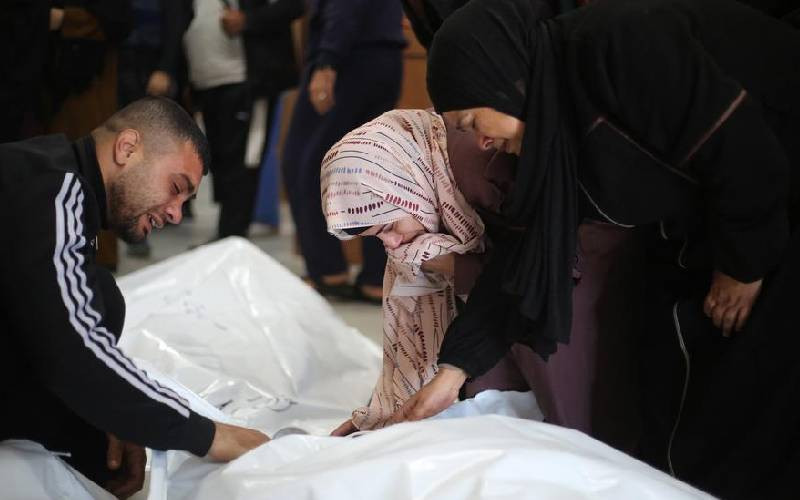 |
|
Sharon Jepchumba Korir who succumbed to rabies after a dog bite. |
No matter how much falls on them, they keep ploughing ahead.
Decades ago, one family lost their eight-year-daughter to rabies. But Agnes and Barnaba Korir could not let their lovely girl end up just a statistic. Her death was not in vain.
As the globe marks the World Rabies Day tomorrow, the family, in collaboration with partners, is driving an initiative toward eliminating a disease that kills 100 per cent of infected patients.
Their vaccination drive is aimed at reducing rabies infection, which kills 2,000 Kenyans annually, saving the man from his best friend. At least 98 per cent of human rabies cases are attributed to rabid domestic dogs.
The story of the Korirs was weaved on Christmas festivities. The family had visited Sironoi Village in Nandi County, where they spent the holiday with relatives in the allure of the green countryside.
Together with her cousins, their daughter Sharon, went to harvest guavas a day after Christmas when a dog began chasing them. The canine closed in on Sharon, biting her on her upper back.
An uncle called her parents who were in a nearby town. “We advised them to meet us at Mosoriot town and we took her to hospital where she was treated,” her mother, Dr Agnes Korir, a lecturer at Daystar University told The Standard on Saturday.
“We didn’t think it was that serious because it appeared like a small scratch on the back and after treatment, we returned to Sironoi where we spent a couple of days before we returned to Nairobi to prepare for school that was due the first week of January,” said the father Barnaba Korir, the chairman, Athletics Kenya in Nairobi.
At this point, her mother picks up with the narration highlighting the medical sojourns after Sharon reported to school on January 12, 2004. They received a call from her teacher that she was unwell and needed urgent medical attention.
“When I picked her at school, she was restless, weak and had been vomiting and I took her to three hospitals, as each kept referring us to a higher level for specialised treatment,” Agnes said.
After treatment, they went home but the entire night, her mother says, Sharon hardly slept and kept moving from one room to another in search of a comfortable spot to rest.
“We placed mattresses on the floor of the sitting room to catch some sleep but at around 3am, she got worse and we took her to hospital where she was on and off lapses of consciousness,” she narrated the events of what would later turn into a long morning in hospitals.
While at the hospital, her mother says, Sharon wanted to go to the wash-room and as she helped her, she became forceful and attempted to bite her mother’s stomach, but was held back by the heavy layer of clothes she had worn to beat the morning chill.
“That’s when I knew that my little girl was quite sick and rushed to the nurses and doctors and explained what had just happened and they referred us to two other hospitals as we sought the best care for Sharon,” she recounts.
It was at the second health facility that the Korirs were informed their daughter had active rabies and their minds flashed back to the dog bite sustained three weeks earlier at their rural home.
Stay informed. Subscribe to our newsletter
We put our trust in God to work through the doctors and nurses in the Intensive Care Unit as they placed her on life support, but the diagnosis was not communicated in a humane way, the Korirs say. “We are treating your daughter as a rabies patient. Even if she lives, her heart and brain are dead,” they quote the piercing words.
On learning that their daughter was in grave danger, the Korirs offered each other support in what was becoming a tough course by the minute.
At noon, they were informed that their third born daughter had succumbed to active rabies and the painful journey of losing her later culminated into the beginning of a worthy cause to create awareness of rabies in the country.
“She was an extremely humble, selfless girl and after her one year anniversary some of our friends, Barnaba’s former track coach, Bill Bergan from Iowa State University and former team-mate Bob Verbeek founder of Glozo Sports, pledged their support to celebrate her life,” Agnes says.
Tomorrow, as Kenya launches a five-stage plan in Kathonzweni, Makueni County, Sharon Jepchumba Korir, is posthumously being celebrated as a heroine by a foundation started by her parents and friends.
And when it took away their daughter’s life on January 13, 2004, they made a pact to let Sharon live by starting a health advocacy aimed at creating awareness and making available the anti-rabies vaccine.
“Saving lives throughout Kenya, and giving a future to those who need it most,’ is the message on their homepage on www.sharonliveon.org, that seeks to provide vaccines for the mass vaccinations of dogs that are the main source of rabies infections in humans.
Develop symptoms
Rabies is known to cause death in all persons who develop symptoms after the virus is contracted through wounds arising from scratches or bites from an infected animal.
The first rabies outbreak in Kenya was traced in a dog in 1912 in the outskirts of Nairobi, and the first case of human rabies was documented in a woman from the Lake Victoria basin region in Western Kenya in 1928. Dr Eric Osoro, Head of the Zoonotic Disease Unit (ZDU) that handles human-animal health matters, describes rabies as a top killer despite being rarely mentioned.
Countries that have taken the trophy in eliminating rabies include Mexico, Indonesia and Philippines with a primary focus on mass dog vaccination, dog population control, improved dog bite management, public education, and improved diagnosis surveillance and monitoring in 2007.
To achieve this status, animal-health experts are confident that mass vaccinations targeting 70 per cent of the dog population in each region annually for the next three years will rid Kenya of this neglected disease.
According to Osoro, the five-stage elimination model envisions that in the next one-and-a-half decades, rabies will be eradicated through sustained mass dog vaccinations, providing vaccines for use in humans before and after exposure and also through sustained public health education.
Themed, ‘Towards a Rabies-Free Kenya; vaccinate your dog save lives’, the campaign begins in Kitui, Makueni, Machakos, Kisumu and Siaya, which are known to have the highest number of cases of the disease. The roll-out will involve national and county government and partners to avail dog and human vaccines to be used in these pilot counties
Besides public education, the centre is also enhancing access to vaccines for all persons exposed to rabid dogs. Dr Austin Bitek of ZDU ,says the government currently procures 50,000 human vaccines, which is only ten per cent of the actual demand of the vaccine in Kenya leading to stocks out in government facilities, thus patients have to buy the vaccines from private institutions.
According to Dr Bitek, treatment for exposure to rabies costs Sh15,000 per person if sourced from private facilities, translating to a huge burden on most families and worse if more than one member of the family is affected compared to the more cost-and-effect advised strategy of vaccinating dogs at Sh100.
Additionally, the reporting system will be improved to capture all rabies cases and the number of laboratories that can test for rabies increased from the current three to nine, he added.
The Sharon Foundation has supplied 300,000 rabies vaccines, antibiotics and dewomers for dogs and cats, mostly in Nandi County, through the support of the Korirs our friends in the United States of America.
“In the past year, several counties like Kakamega, Kisii, Nairobi, Kericho, Taita Taveta and Busia have requested the foundation for assistance due to increase cases of dog rabies,” Agnes noted.
These ambassadors are hopeful that with thorough collaborations amongst workers in human health and veterinary fields, partners in government, non-governmental, and international agencies, Kenya will be among the first African countries to eliminate rabies.
 The Standard Group Plc is a
multi-media organization with investments in media platforms spanning newspaper
print operations, television, radio broadcasting, digital and online services. The
Standard Group is recognized as a leading multi-media house in Kenya with a key
influence in matters of national and international interest.
The Standard Group Plc is a
multi-media organization with investments in media platforms spanning newspaper
print operations, television, radio broadcasting, digital and online services. The
Standard Group is recognized as a leading multi-media house in Kenya with a key
influence in matters of national and international interest.
 The Standard Group Plc is a
multi-media organization with investments in media platforms spanning newspaper
print operations, television, radio broadcasting, digital and online services. The
Standard Group is recognized as a leading multi-media house in Kenya with a key
influence in matters of national and international interest.
The Standard Group Plc is a
multi-media organization with investments in media platforms spanning newspaper
print operations, television, radio broadcasting, digital and online services. The
Standard Group is recognized as a leading multi-media house in Kenya with a key
influence in matters of national and international interest.









